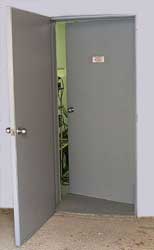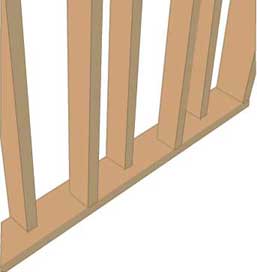As much as we all love home theater movie soundtracks and music at realistic playback levels (“realistic” does not necessarily mean extremely loud), most of us have to deal with other people in our lives—family, roommates, companions, younger children and/or older relatives in the house, or neighbors in nearby, adjacent or adjoining homes. Even if you live in the woods or on the plains, there is still the pervasive problem of preventing the sounds that you enjoy from traveling through your dwelling's structure to other rooms to annoy those who may not appreciate your late-evening movie or music tastes.
An added benefit of soundproofing your home theater room will be that the soundproofed room will also keep annoying noise and outside sounds from entering the room. You'll have created a peaceful and quiet sanctuary in your home that shuts out the noise and clamor of daily life, be it car horns, coffee grinders, leaf blowers, or loud music on inferior playback systems (even those with wheels attached). Quiet spaces bring a measure of tranquility to our lives.
That said, soundproofing is a rather complex subject best treated in several articles.
Different approaches are required for new home construction or for soundproofing a room in an existing home. Soundproofing after the fact may involve building a room within a room, literally, depending on just how much sound you want to keep in and keep out of the room.
How Sound Travels
Let's look at sound, and think about how it travels in order to better understand how to stop it or contain it. Sound is made up of energized pressure waves in the air that cause objects in its path (including our eardrums) to vibrate—objects like walls, floors, doors and ceilings. When the sheetrock or plaster wall vibrates, those vibrations travel through the wooden supporting studs and joists (and to the drywall on the other side) conducting the energy to the next room and through the connected framing of the house. Deep bass energy is the worst, as you may have noticed when you walk past a dance club or when a car with a booming one-note subwoofer passes by your home.
Stopping sound in its tracks
There are three essential things that will stop or reduce the intensity of sound waves: air, mass, and distance. For example, a 6-inch-thick concrete wall has lots of mass, so it will stop a lot of sound because the sound waves lose energy trying to move the mass of concrete.
Anything that's heavy will help stop sound waves, and that includes adding a double layer of drywall, with alternating seams and with one layer placed vertically and the other layer(s) horizontally. Conversely, lightweight materials are largely useless in preventing sound transmission, with the exception of fiberglass batts used to loosely fill the cavities between walls.
Soundproofing and sound absorption
Don't confuse soundproofing with sound absorption. Sound absorption uses carpet, heavy draperies, closed-cell foam or similar material within a room to curb or absorb reflections, essentially to stop excessive echoes and reverberation. However these materials will do little to prevent the transmission of lower-frequency bass and vibration through the walls and studs and midrange sounds through air leaks to other rooms.
Obviously, sound loses intensity with distance, because the air offers resistance. If your house is a mile away from your neighbor's, it's unlikely the sounds from a subwoofer will ever travel that far. But within the confines of a house, any passageway that allows air to escape will allow sound to travel out of the room. Doors and windows are especially vulnerable, but don't ignore electrical boxes (AC outlets), wall plates, and heating ducts. The electrical boxes and wall plates can be sealed with a non-hardening silicone caulk. Interior sound absorbing baffles for heating ducts are available from specialty soundproofing supply companies.

Dual steel doors insulate Axiom's soundproof testing room where loudspeaker drivers are tested at power levels up to 1200 watts, which produce loudness levels as high as 135 dB SPL.
Replace hollow-core doors
Domestic hollow-core doors, for example, are largely hopeless at reducing the passage of sound. Replacing those with solid wood doors will help considerably. A steel door (again mass is important) will be superior and best of all are two doors, with effective weather-stripping seals on each side. (Remember that one door has to open inwards and the other outwards.)
Like hollow-core doors, single-pane windows have very little sound insulating properties. Double pane windows with an air space between the panes improve things considerably.
Dampening Vibration
The big word here is using non-hardening silicone caulk combined with different materials. Adding a second layer of sheetrock to a wall and studs coated with silicone where they meet will lessen the transmission of vibration. Adding a 6-inch air space between one side of the wall and the other will further reduce the transmission of sound. Filling the air space loosely with fiberglass will further increase transmission loss.
Dual layers of drywall (sheetrock, gypsum board) with silicone caulk between them are very effective, and adding a bead of caulk to the studs before the sheetrock is screwed or nailed will dampen vibrations. You can even get lead-lined sheetrock. Here, not only is the mass effective—it's very heavy—but the differing materials also help. Using different layers and kinds of material will reduce sound transmission significantly.

Overhead view of dual layers of sheetrock: place silicone caulk between
the layers as well as where the sheetrock attaches to the studs.
The Staggered-Stud Wall
This type of wall is a clever way of preventing the vibration on one side of a wall from

reaching the other side. A 2 x 6-inch base plate is used with alternating 2 x 4 studs arranged so that the 2 x 4s on one side do not connect with the wallboard on the other side of the wall. In other words, there are duplicate rows of 2 x 4s, in a staggered arrangement (see illustration, right) with the inside wall attached to one set of studs and the outer wall attached to the other set of alternating 2 x 4s. It's a clever way to achieve a high STC (sound transmission class) rating.
STC Ratings
Sound Transmission Class (STC) is a numerical rating given to various materials indicating how resistant the material is to transmitting sound. The higher the STC rating, the greater its soundproofing ability and transmission loss. The lower the number, the more porous a particular material is to the passage of sound and noise. For example, a single-pane window or hollow-core door has a rating of about 20, offering only a slight reduction in sound transmission. But a staggered-stud wall with fiberglass filling the air cavity has a rating well above 50.
Here are some sample STC ratings for different building materials and combinations.
Material and construction Sound Transmission Class Rating
(the higher the number, the greater the soundproofing ability)
| Hollow-core door or single-pane window |
20 |
| Lightweight 8-inch concrete block, both sides sealed with latex paint |
46 |
| Single row 2 x 4 wood studs with single layer 5/8-inch Gypsum board (sheetrock) each side |
35 |
| Filling cavity with 3.5 inches fiberglass |
38 |
| Double-row 2 x 4 wood studs, 1-inch plate separation. Single-layer 5/8 gypsum board each side. |
45 |
| Filling air cavity with 3 inch fiberglass batts |
56 |
| Same as above but double layers gypsum board each side and dual layers of 3.5-inch fiberglass |
63 |
As can be seen, alternative construction techniques with dual layers of sheetrock combined with double-row or staggered stud construction and fiberglass can raise the soundproofing considerably past that of a concrete block wall.
These soundproofing techniques can be applied to construction of a dedicated basement home theater room in an existing house or to new home construction. The next article will deal with soundproofing an existing room in a house by building a room within a room.







